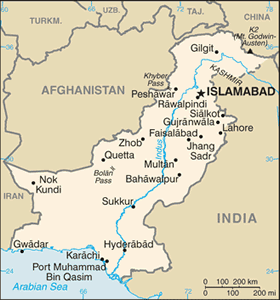The Geography of Pakistan
The Geography of Pakistan
Pakistani Geography
Location: Southern Asia, bordering the Arabian Sea, between India on the east and Iran and Afghanistan on the west and China in the north
Geographic coordinates: 30 00 N, 70 00 E
Map references: Asia
Area: total: 803,940 sq km land: 778,720 sq km water: 25,220 sq km
Area - comparative: slightly less than twice the size of California
Land boundaries: total: 6,774 km border countries: Afghanistan 2,430 km, China 523 km, India 2,912 km, Iran 909 km
Coastline: 1,046 km
Maritime claims: territorial sea: 12 nm contiguous zone: 24 nm exclusive economic zone: 200 nm continental shelf: 200 nm or to the edge of the continental margin
Climate: mostly hot, dry desert; temperate in northwest; arctic in north
Terrain: flat Indus plain in east; mountains in north and northwest; Balochistan plateau in west
Elevation extremes: lowest point: Indian Ocean 0 m highest point: K2 (Mt. Godwin-Austen) 8,611 m
Natural resources: land, extensive natural gas reserves, limited petroleum, poor quality coal, iron ore, copper, salt, limestone
Land use: arable land: 24.44% permanent crops: 0.84% other: 74.72% (2005)
Irrigated land: 182,300 sq km (2003)
Natural hazards: frequent earthquakes, occasionally severe especially in north and west; flooding along the Indus after heavy rains (July and August)
Environment - current issues: water pollution from raw sewage, industrial wastes, and agricultural runoff; limited natural fresh water resources; most of the population does not have access to potable water; deforestation; soil erosion; desertification
Environment - international agreements: party to: Biodiversity, Climate Change, Climate Change-Kyoto Protocol, Desertification, Endangered Species, Environmental Modification, Hazardous Wastes, Law of the Sea, Marine Dumping, Ozone Layer Protection, Ship Pollution, Wetlands signed, but not ratified: Marine Life Conservation
Geography - note: controls Khyber Pass and Bolan Pass, traditional invasion routes between Central Asia and the Indian Subcontinent


